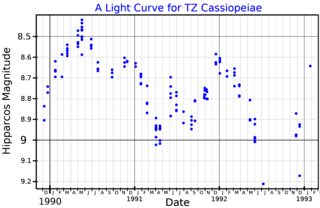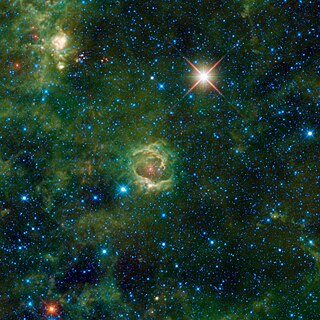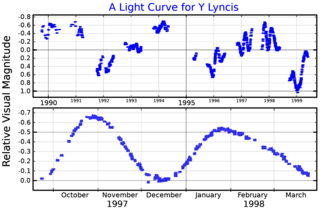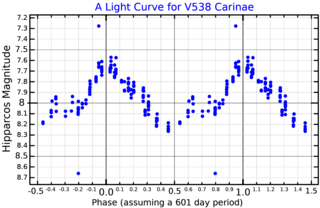| Observation data Epoch J2000.0 Equinox J2000.0 | |
|---|---|
| Constellation | Carina |
| Right ascension | 10h 20m 21.608s [1] |
| Declination | −60° 27′ 15.55″ [1] |
| Apparent magnitude (V) | 7.4 - 9.0 [2] |
| Characteristics | |
| Evolutionary stage | Red supergiant |
| Spectral type | M4.5Ia [3] [4] |
| U−B color index | +2.34 [5] |
| B−V color index | +2.20 [5] |
| Variable type | SRc [6] [2] [7] |
| Astrometry | |
| Radial velocity (Rv) | 2.0 [8] km/s |
| Proper motion (μ) | RA: -7.615 mas/yr [9] Dec.: 2.051 mas/yr [9] |
| Parallax (π) | 0.4143 ± 0.0403 mas [9] |
| Distance | 2,960+220 −200 [10] pc |
| Absolute magnitude (MV) | −5.24 [5] |
| Details | |
| Radius | 1,168 [11] R☉ |
| Luminosity (bolometric) | 288,400+5,300 −7,400 [10] L☉ |
| Temperature | 3,535±170 [12] K |
| Metallicity [Fe/H] | +0.25 [13] dex |
| Other designations | |
| Database references | |
| SIMBAD | data |
EV Carinae is a red supergiant and pulsating variable star of spectral type M4Ia in the constellation Carina. It is a semiregular variable star with its apparent magnitude varying between 7.4 and 9.0 in the visible band, making it only seen by binoculars or a telescope. Various periods have been identified, but the dominant one is around 347 days. [6] It is an MK spectral standard star for the class M4.5Ia. [4]
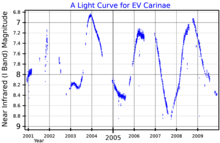
EV Car is one of the largest known stars although its properties depend on its distance. In the late of the 20th century, EV Carinae, based on an assumed distance of 4.2 kpc, was found to be an extremely luminous and large supergiant star with an unusual luminosity between 550,000 and 675,000 times that of the Sun (L☉), which would imply radii of 2,880 to 3,190 times the Sun's radius (R☉) at a temperature of 2,930 K, making it larger than the orbit of Saturn. [15]
More recently, new calculations of the distance derived closer distances below 3 kpc which would put EV Car part of the Carina OB2 association along the Carina Nebula and give the star lower luminosities below 300,000 L☉, higher temperatures, and correspondingly lower radius values, [11] [5] [10] while calculation of the bolometric luminosity based on a Gaia Data Release 2 parallax of 0.7759±0.1098 mas gives a luminosity below 50,000 L☉ with a corresponding radius of 574 R☉, but that value is considered unreliable due to a very high level of astrometric noise. [12]




